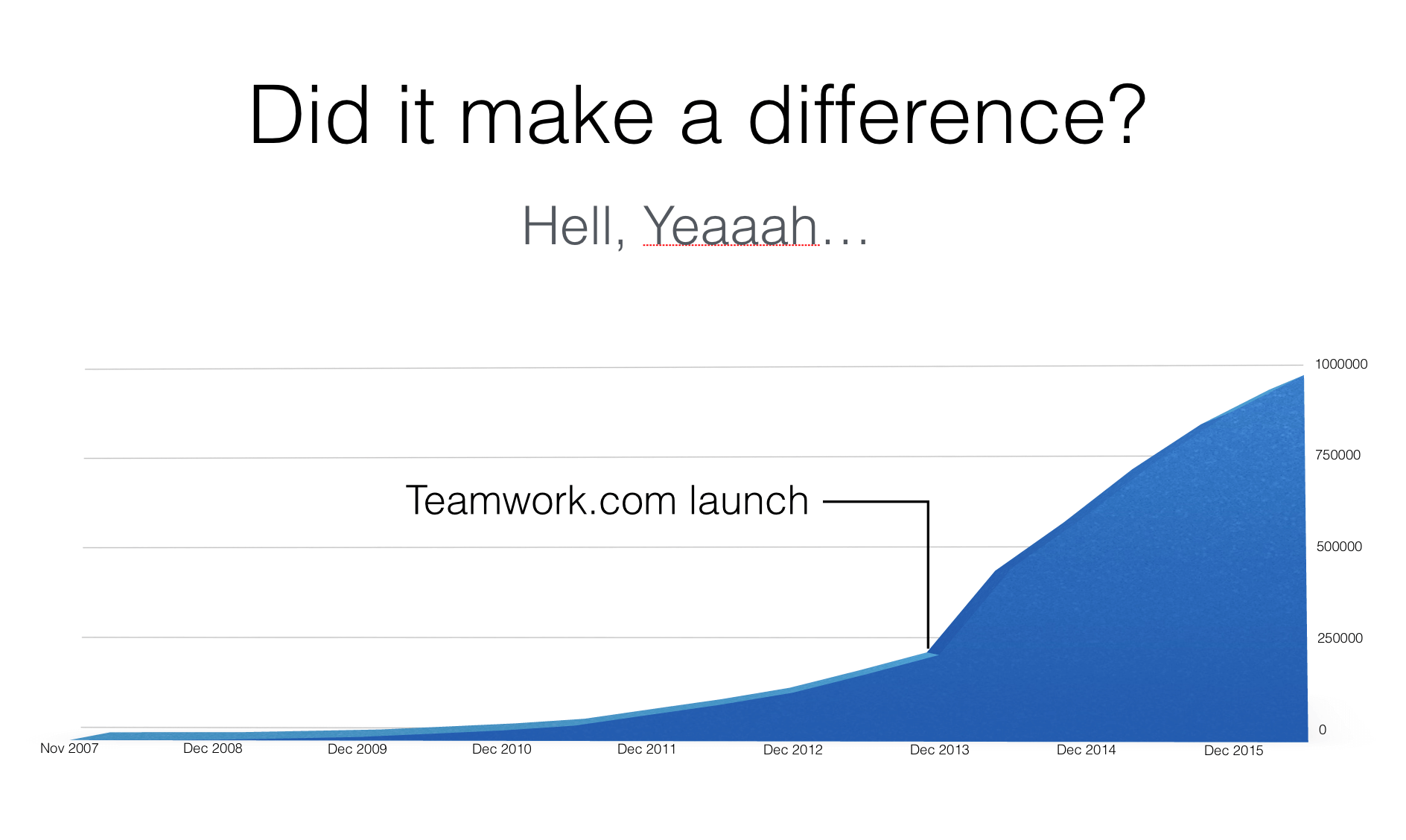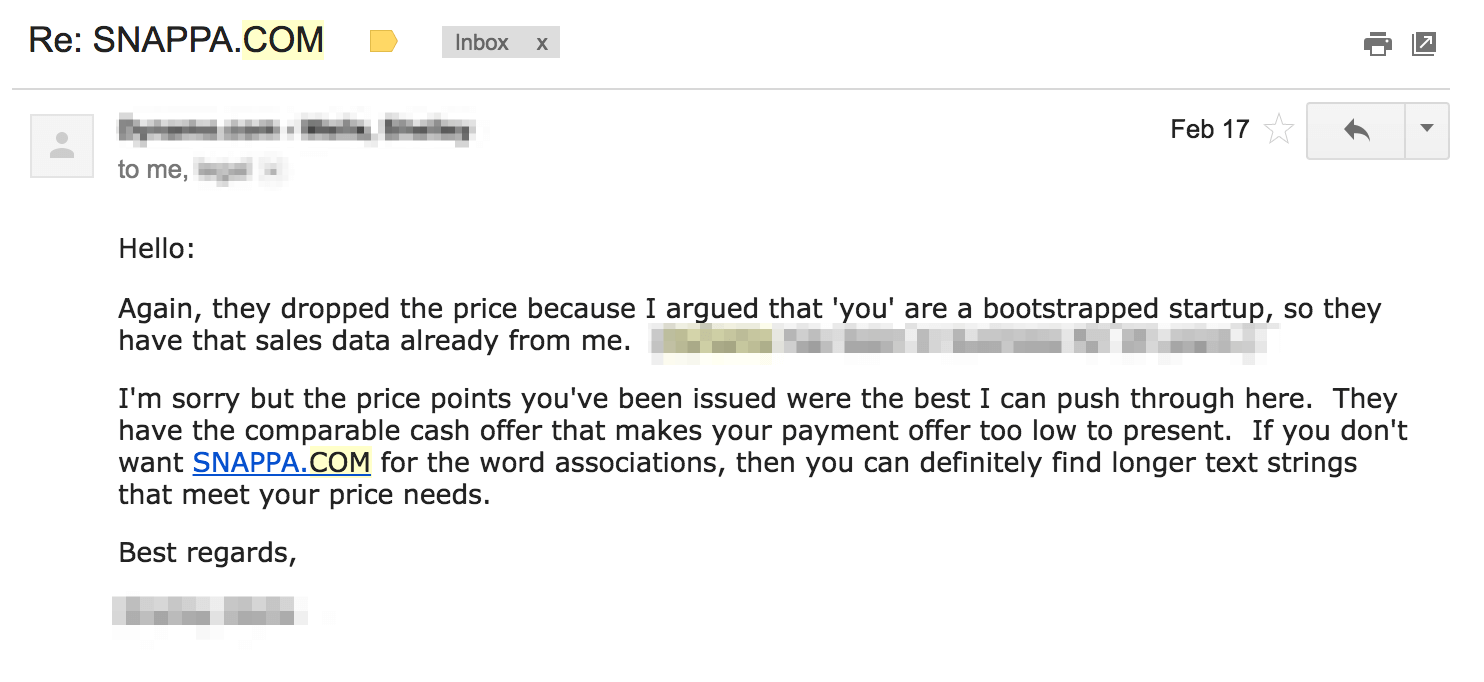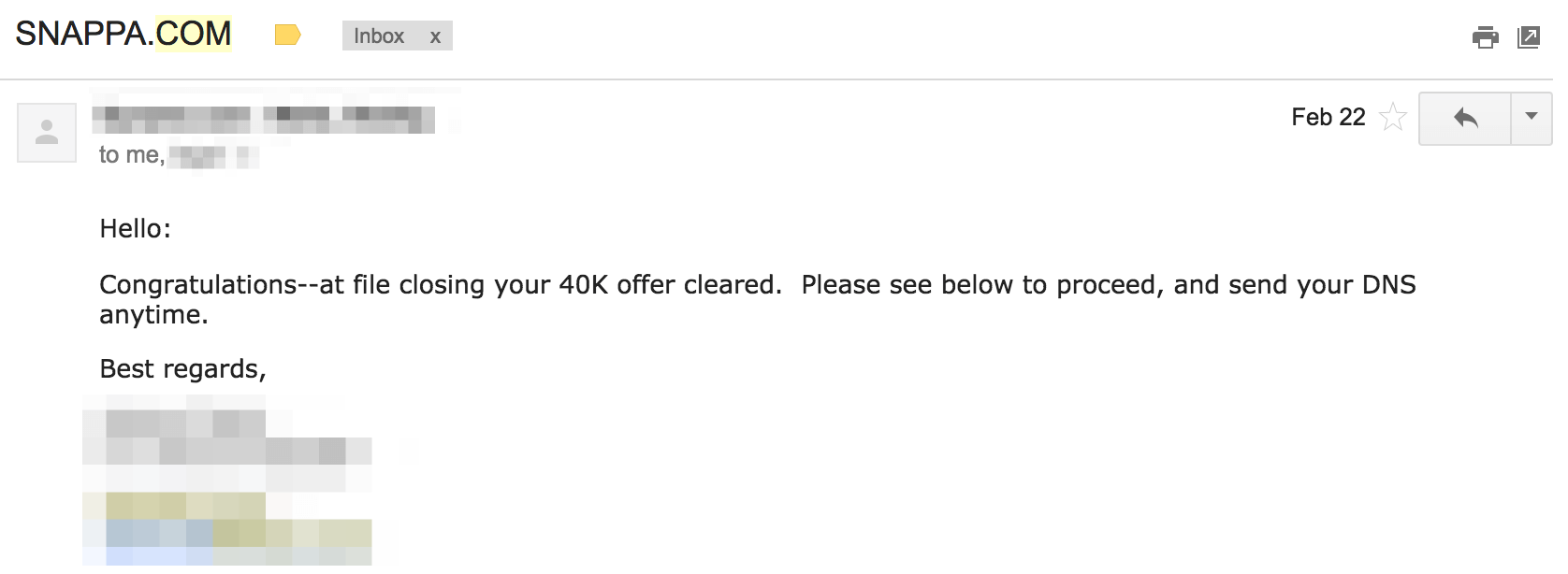In March of 2015, my co-founder Marc started writing the first few lines of code for Snappa. And in order to start collecting email addresses, we needed to throw up a landing page.
Since Snappa.com was taken, we registered Snappa.io and ran with it. But two years later, we ended up purchasing the Snappa.com domain for $40,000 USD. (Deal terms to follow).
After making the announcement, I couldn’t believe how many people were interested in the purchase. In turns out that many founders were also trying to acquire a domain and wanted to know how the deal went down, how much we paid, and what we learned from the experience.
Rather than going through the details with each person individually, I thought it would be more useful to share the entire story in a blog post. My hope is that other founders considering a similar purchase can get value from this post.
So here’s the whole story of how we purchased the Snappa.com domain.
Why we did it
Some people would argue that we were doing just fine with Snappa.io and purchasing the .com was a waste of money. Doesn’t everyone type stuff in Google now?
The reality is we were doing just fine. We had grown to $25k+ MRR without raising any money. So why did we care so much about a domain name?
There’s a few reasons.
1. Branding & Trust
At the end of the day, .com will forever be the ultimate top-level domain (TLD). To this day, there are still plenty of people who don’t even realize that other TLDs exist.
When you own the .com, you’re signalling to the market that you’re legit. And when people are paying you money to use your product, the more trust you can convey the better.
With Snappa, many of our customers pay us an annual subscription. We want them to know that we’ll be around for years to come.
As Joel from Buffer points out, most well-known companies all had “placeholder” domains for a long time before they got their actual name as their domain too:
- Square was squareup.com
- DropBox was getdropbox.com
- Facebook was thefacebook.com
- Instagram was instagr.am
- Twitter was twttr.com
- Foursquare was playfoursquare.com
But each one of these companies reached a level of scale where owning the .com was important. Otherwise, they would have used their placeholder domains forever.
Since we’ve been around for nearly 2 years, we felt it was time to legitimize our company further by purchasing the .com.
2. Avoiding Confusion
Even though most people do in fact type things in Google, there are still a lot of people that don’t. A lot of these people will assume that web addresses end in .com.
In fact, we received a few support requests from users saying that our app was down. It turns out they were entering Snappa.com as the web address (which used to lead to a blank page).

I always thought to myself… how many people were doing the same thing?
In addition to customers entering the wrong URL, we also noticed a few blogs and websites linking to us using the wrong URL. This means we were missing out on referral traffic and link equity.
3. Growth Potential
Last year I attended MicroConf in Las Vegas (which is a great conference by the way). One of the speakers was Peter Coppinger from Teamwork.com.
During his talk, he told the story of how they purchased Teamwork.com for $675k. I was floored…
Then he threw up this slide.

It goes without saying that purchasing the .com wasn’t the only reason their growth exploded. It’s also worth noting that their old domain name was TeamworkPM.net which was pretty horrible.
However, there’s no denying the inflexion point that happened immediately after launching the new domain. Could the same thing happen to us if we purchased Snappa.com?
First contact
After we launched our beta in the Summer of 2015, we were getting some really good traction. So in September 2015, I decided to reach out to the owner of Snappa.com to see if they would be interested in selling. I figured they’d want more than we could afford but figured it was worth a shot.
As Buffer mentions in their acquisition story, there’s a variety of ways one could go about contacting a domain seller. Some tactics involve emailing from a Yahoo address, to hide your true identity to make yourself appear like a smaller company or letting a different entity altogether work on getting the domain.
Luckily, we were a small company. I also felt that at some point in the negotiation I’d have to reveal my true identity anyways, so I didn’t put too much thought into deceptive tactics.
Here’s the the first email I ever sent the seller. I used my real name and personal Gmail account.

A couple days later, Marc and I were having lunch at a restaurant when my phone buzzed. It was an email from the seller containing a domain name transfer agreement.
I scanned through the document and eventually saw the purchase price…
$79,500 USD. Ouch!
At that moment in time, we had 0 paying customers because we were still in beta. Naturally, we decided to put our dreams on hold.
Second contact
A month ago (February 2017), I heard the news that Noah Kagan spent $1.5M to acquire the Sumo.com domain and I thought he was crazy.
Then I listened to his podcast episode where he talked about the acquisition. He mentioned that a good domain equals a legit company and it lets you own your brand and be the definitive source. Because so many other companies had ‘Sumo’ in their name, Noah wanted to position his company as the original, the de facto.
As I reflected more on the purchase, I realized that Noah wasn’t crazy. In fact, I applauded him for such a ballsy move.
I also learned two things from Noah that helped me acquire Snappa.com.
- He didn’t take no for an answer. Noah was getting repeatedly shut down for 7+ years but his perseverance paid off.
- Noah didn’t pay the $1.5M all up front. He worked out a payment plan with the seller that made the acquisition price more manageable.
Feeling inspired, I reached out again to the owner of Snappa.com on February 8, 2017 (one year and five months after my original email).
Even though the original transfer agreement they sent me said the price was non-negotiable, I knew that just wasn’t true. So to get the ball rolling, I sent a low-ball offer of $10,000 USD to feel them out.

A few days later, I got a new domain name transfer agreement…
… for $84,500 USD!
A $5k increase from the previous year. Not looking good…
Determined to negotiate, I fired back the following email.

The seller responded that they’ve already turned down another offer far above our original offer of $10k. They also asked if we’d consider a payment plan.
Even with a payment plan, $84.5k was out of the question. So I fired back another offer and increased our offer to $20k.

That same day, I received the following email.

Alright… now we’re getting somewhere.
Real Negotiations Begin
At this point, I called Marc and we had a lengthy discussion about how important it was to own Snappa.com and what was the maximum amount of money we’d be willing to pay for it. Considering how far apart we were with the seller, I felt like we had to give them our best offer to even get a chance of acquiring the domain.
Remember that Snappa is 100% self-funded. We’re not sitting on a pile of cash that we raised from investors so we have to be very careful with how we spend our hard-earned cash.
After talking with Marc, we agreed that $40,000 USD was the absolute most we wanted to spend on the domain. Also, we couldn’t afford to pay the $40k up front because it would put a serious dent in our cash flow. We needed to make sure we had adequate funds to cover all our costs in case of an emergency.
I then fired off an offer of $40k USD with a 5 year payment plan. Once again it was turned down.

Even with a payment plan, $59.5k was still more than we wanted to pay and $50k upfront was out of the question. So I decided to stand strong and give the absolute best offer that we could.

I had high hopes, but they came crashing down quickly when I received the final blow.

I was pretty disappointed. But we just couldn’t justify spending that kind of money on a domain name as a bootstrapped startup.
I also remembered an important tactic when it comes to negotiations…
Be willing to walk away.
And that’s exactly what I did. I stood firm and let the seller know that we couldn’t justify their asking price and that we’d carry on with our current domain name. They came back with one final knockout blow.

It sucked. Over the next few days, I started coming to terms with the fact that we may never own Snappa.com.
Then out of the blue, 5 days after our previous exchange, I received the following email.

BOOYA!
We finally agreed on a purchase price of $40,000. The final deal terms were $20K paid up front with the remainder paid in annual instalments over the following 3 years.
As soon as the DNS was changed and the agreement was signed, I wired over the first payment on March 1, 2017.
Lessons Learned
The entire process was very stressful. After our final offer was accepted, I couldn’t help but wonder if we were making the right decision. We certainly didn’t have a crystal ball that could tell us what the impact of having Snappa.com would be in the long run.
But now that we’ve fully transferred over to our new domain, there’s no doubt in my mind that we made the right decision. It just feels right.
As I look back on the experience, a few key lessons jumped out at me, some of which I alluded to throughout the post but I think they’re worth repeating.
1. There’s no such thing as non-negotiable. Every time I contacted the seller, I kept getting the same template with a fixed price that was non-negotiable. Even after submitting a few lowball offers, they still wouldn’t budge. Yet in the end, we were able to settle on a price that was less than half of their asking price.
2. If you really want something, you have to be persistent. There’s no way this deal would have gone through if we weren’t persistent. Despite multiple offers being rejected, we kept trying until we succeeded.
3. Be willing to walk away. Negotiating is all about leverage. If the person on the other end knows that you want something REALLY bad, they’ll make you pay for it. They only accepted our final offer after we made it clear that we weren’t going any higher.
4. Be vulnerable. The truth is, we were a small startup. We didn’t have $84k to spend on a domain name. Without sounding like a charity case, we did try to drive the point across that we only had so much that we could offer.
5. You can negotiate on more than just price. If we had to pay $40k up front, we wouldn’t have been able to make this deal. The payment plan is what made this feasible. If you’re negotiating something and you can’t justify the price, try to defer payments in order to ease the financial burden. In the case of domain names, the seller will still technically own the domain until they receive the final payment. Therefore, there’s zero risk on their part.
Parting Thoughts
Only time will tell whether or not the $40k investment yields a positive ROI. Then again, we may never know.
But regardless of whether or not the investment pays off, we never have to worry about another business using Snappa.com. That in itself is priceless. Now we can go back to building a kickass product!
One more thing…
Don’t let a domain name stop you from starting your business. If I had to rank the importance of a domain name when starting up, I’d give it a 3/10. Your preferred domain name will probably be there waiting for you when the time is right.
 I’m Christopher Gimmer. I’m an entrepreneur and the co-founder of
I’m Christopher Gimmer. I’m an entrepreneur and the co-founder of
Comments on this entry are closed.
Great article. But I disagree about the perfect domain being there waiting for you.
I have witnessed many situations were numerous companies had the same name or keyword in their brand name. Maybe with a brandable like Snappa.com which is not a generic dictionary word. As in the case of Cars.com or Sumo.com that you referenced, there are several companies using the generic dictionary term ‘Sumo’ and if any of those other companies were to have purchased Sumo.com they would never relinquish it…
My advice to startups is to make a list of 50 possible brandnames, search for the domain, categorize them into taken with a active site or taken with a parked page. You will have your best luck buying from the park pages, because that means they are usually for sale. Get an asking price for all the domains in the 2nd list, then reach out to the sites owned by businesses, and ask if they would sale.
Once you have this information, then you can have a better idea of what to name your company. What I see as a unnecessary error is to name your company first, then try to get the domain later…
Great feedback/advice. Thanks for commenting.
Christopher,
Thank you for being an ethical domain name buyer by using your real name and identity.
I cannot tell you how unethical many prospective buyers of domain names are by using fake names, fake phone numbers, temporary email addresses, third parties, and other shenanigans when they try to buy from me a .com domain name that I own.
I also own physical real estate like empty lots and other raw land. I never get unethical behavior from physical real estate buyers — they always approach me with their real identities and real company names. It’s so refreshing to deal with legitimate business people who are not trying to deceive you through fake personas or outright lies about who they are or what their intent is with the domain name (e.g., “I’m just a poor student wanting to use Word.com for a school project”, said the EVP of a large, publicly-traded corporation).
Kudos to you for being a true businessman in seeking to ethically acquire someone else’s property that you desire to own and finding a way to pay for a virtual asset that has significant real world value.
Best wishes to your success!
Anon
Great story only one problem:
“Your preferred domain name will always be there waiting for you when the time is right.”
No, your preferred name will not always be there. Another company can buy it and you may never ever get it. So grab it when you have a chance.
Thanks for sharing Christopher, this was a great read – I agree with your reasoning expect for your parting thought that “your preferred domain name will always be there waiting for you when the time is right.”
This is only correct if the preferred domain name is owned by a individual or investor who is actually willing to sell that domain. Often startups launch with a brandable or generic name such as health insurance company Oscar which raised a whopping $727 MILLION in funding but still needs to operate from the silly HiOscar.com domain name because Oscar.com is owned by the Academy Awards organisation.
Very good point Doron! Thanks for sharing.
This is excellent Christopher! Domain acquisitions like this have been a clandestine game of cloak and dagger for many years. I am glad that you have brought to light some of the struggles both buyers and sellers go through during the negotiation process.
I do have a question for you; what made you wait 17 months to check back in with the registrant/owner?
It was simply a cash flow issue. When we were starting up, our main priority was hiring. It only made sense to pursue the .com when we did.
That makes sense Christopher. Typically that is the biggest issue companies have when acquiring a domain. You didn’t let the price tag stand in the way, after all the price of anything is just a reflection of it’s value not an obstacle. Congratulations of your acquisition Christopher, I know you will get a lot of value out of this domain especially at this price point.
Extremely wise purchase Chris and one very often over looked aspect without owning the premium .com domain to your brand is EMAIL. Email is so vital and since most will assume you own the “brand” .com, they try to communicate to you that way, on assumption or “natural” form that you own that domain. What kind of email communication are you missing not owning the .com? Snappa was very likely missing many, many of those being very important! Again, wise purchase and well worth every penny of that $40K.
This was a very enjoyable read. There is no question it was worth it and the smart move.
My question is next time you need a domain name, do you think you would go in there a little more stealth? So the guy can’t figure out why you really want the domain so bad? haha
On the plus side I am totally going to try out your website because the one thing I hate so much is trying to make graphics! If it makes it that easy I am going to be a customer for sure!
Thanks for posting this Chris. I’ve been on both sides of the domain market (buying and selling) and it is always an adventure!
Superb very detailed article. .COM domains are still the prime digital addresses for serious businesses. Just for your information there is a number of brandable domains marketplace with ready-to-sell .com branding solutions for any type of businesses. You can check BRANDPA.com, Brandbuckeet.com or DomainsDeck.com (last one is my private collection) for this aim. Sometimes it is better to rename your company and buy smth interesting from places such these markets (x xxx USD ) when trying to buy your .COM for 40-90k USD.
I know this post is from a long time ago, just wondered if you wanted to share an update. Also a follow up question, do you see the value in buying up other key domains for snappa, like snappa.co.uk or snappa.com.au? What is your recommended strategy here? Is it important? or do you just stick to the .com?
Cheers TJ
Hey TJ,
Now that almost three years have gone by, we’re very happy that we purchased the Snappa.com domain. In terms of revenue, we’re much further along now than we were at that time so the purchase price wasn’t all that bad in retrospect. That being said, the growth of our company shouldn’t be attributed to the fact that we changed to .com. We still would have continued to grow if we had simply kept our .io domain but I think the .com is certainly better from a branding perspective.
In terms of buying up other domains like .co.uk and .com.au, I don’t really think it’s necessary since .com is the dominant domain extension.